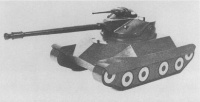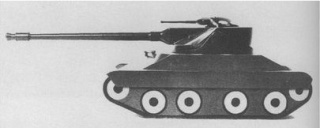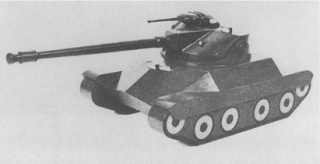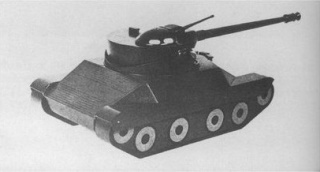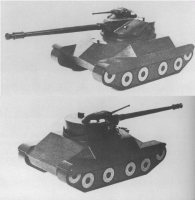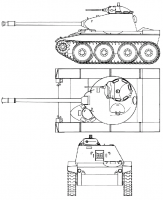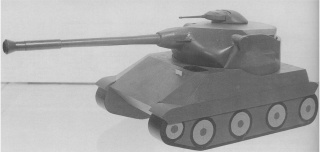T71
T71 (Stock)
| 1400000 價格 |
| 840 血量 |
| 17.79 / 18 公斤重量 |
- 車長
| 25.4/22.2/19.1 前/側/後,毫米車身裝甲 |
| 22.2/22.2/22.2 前/側/後,毫米砲塔裝甲 |
| 340 匹馬力引擎功率 |
| 64.4 公里/小時最高時速 |
| 54 度/秒迴轉速度 |
| 115 標準砲彈殺傷力 |
| 128 毫米標準砲彈穿透力 |
| 12 完全裝填的時間 |
| 42 度/秒砲塔迴轉速度 |
| 400 公尺可視範圍 |
| 410 公尺訊號範圍 |
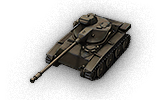
The T71 is a tier 7 US light tank.
Compatible Equipment
Compatible Consumables
Player Opinion
Pros and Cons
Pros:
- High auto-loader burst damage with acceptable drum reload time
- Excellent mobility in all respects (top speed, traverse, acceleration)
- Can easily circle enemies and take them out without taking hits
- Excellent view range
- Upgrades are relatively quick to unlock.
Cons:
- Due to the unusually large engine blocks and tracks, a single shot has a high chance to detrack you and break your engine.
- Subpar accuracy
- Fairly large profile, especially compared to its main competitor, AMX 13 75
- Both the commander and the gunner are loaders
- APCR and HEAT rounds have poor normalization which can be a liability against sloped armor.
Performance
In-game, it possess similar properties to the French AMX series of light tanks. The pacing between shots is 2 seconds on both guns in a 6-round revolver magazine. It has good dynamics, but care should be taken to avoid being hit in the hull, as the engine is especially weak when stock and is destroyed easily.
The gun is decent to good for its tier, with 900 potential burst damage over 10 seconds. 175 penetration is acceptable given the light tank chassis, which encourages flank and rear shots. As with the French tanks, the best combat strategy is to flank a distracted enemy and unload as many of your rounds into their weak areas as you can without taking damage, then withdrawing to repeat on other targets of opportunity. Special attention should be given to one-shot targets, as the T71 can kill several weak tanks very quickly given the chance. Because of its great turning and top speed it can also circle tanks with slow-turning turrets, leaving them entirely defenseless. This should only be attempted on isolated tanks, however.
Its great view range and good agility make it an excellent scout, both active and passive. Active scouting at these tiers becomes risky, however, as both alpha and accuracy are better than previous scout tanks have seen. Also, active scouting increases the chance of getting into a confrontation with a high-tier medium, a situation the T71 is ill-equipped to deal with.
Early Research
- The top cannon is 500kg lighter than the stock one; by researching this, you save on tracks for a while and can mount some equipment.
- The upgraded engine gives you an additional 60 horse power and more than double amount of module hitpoints.
- The Tier X radio almost doubles the signal range, boosting it from 410 to 745 metres.
- The tracks are not required to mount anything, but give better terrain passability and better track traverse.
Historical Info
Little is known on this unusual US tank because the T71 never actually made it out of the factory and onto the battlefields. It suffered the fate of many interesting vehicles that were thought up in the post-war era, when the US tank manufacturing industry was very rich in ideas but became increasingly poor in funding. Armed with the experience gained from the industry’s previous rapid expansion, the US engineers were looking to improve their entire line-up of light, medium and heavy tanks, and try out new and sometimes experimental designs on them. When some of those experiments didn’t turn out quite as everybody had hoped for, projects were quickly dropped, as in the case of the T71 that only existed in mock-up form and never actually saw the light of day.
The few available records say that its development began in the early 50s when the US Ordnance Committee ordered a new light tank with very specific characteristics, aimed at replacing the T41E1 –which itself had already been the improved successor of an upgrade of the experimental light tank T37. Being the third generation of an experimental vehicle, the T71 was meant to continue the same bold nature by sporting a heavy 90mm calibre gun on a 20 ton light weight structure. Manufacturers such as the Detroit Arsenal Tank Plant put forward their plans featuring an oscillating turret that would be able to handle the recoil of the cannon. This was a rather unusual technology that was only used in a couple of tanks worldwide. As the tank was meant to be carried airborne, its ultimate weight had to be reduced even further, which limited possible armament to a 76mm gun, but in turn enabled the use of an auto-loader.
The designers had bet on quantity over quality, giving the tank an impressive firing rate (before the unavoidable drum reload of course) and an ammo rack capable of carrying up to 60 shells of different types. Light-weight and equipped with a decent AOI-628 engine in the rear hull for agile quickness, the engineers thought they had created a nimble scout and artillery support tank. However, they had forgotten an important aspect: the armour. Due to the imposed weight restrictions, the tank was covered in “paper-thin” 25 mm armour which failed to impress the Ordnance Committee. Ultimately its performance just did not live up to the necessities of changing warfare of its time. The project was scrapped in 1953 with nothing but a wooden model to show for it.
Historical Gallery
Sources and External Links
| Light Tanks | |
| Medium Tanks | |
| Heavy Tanks | |
| Tank Destroyers | |
| Self-Propelled Artillery |
| USA | |
| UK | |
| Germany | |
| USSR | |
| China | |
| Japan |
